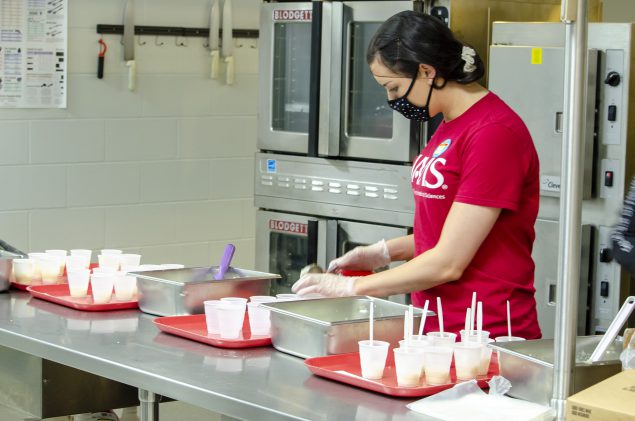Arkansas Is Making School Lunches More Heart-Smart
Download the story [PDF – 605 KB]
More than 40% of adults in Arkansas have hypertension, also known as high blood pressure,1 a leading cause of heart disease and stroke.2
In recent years, pediatricians have also seen a steady increase in the number of children with hypertension.3 But it may be possible to reverse this trend, and one key to lowering blood pressure is healthy eating habits, which can begin early in life. Reducing sodium intake helps bring blood pressure down.
Children’s diets are in the hands of the adults in their lives, including the schools that serve their lunches. So, the University of Arkansas for Medical Sciences (UAMS) Northwest partnered with school districts in the northwestern part of the state to help kids develop a taste for healthier, lower sodium foods. The team analyzed school menu items and found low sodium alternatives to high sodium foods.
Public Health Challenge
Only about 8% of adults in Arkansas eat the recommended daily servings of fruits and vegetables.4 This makes improving the dietary habits of young people in the state even more important.
About 64% of children in the state are eligible for either free or reduced-price school lunches,5 so the UAMS team reasoned that they could make a broad and lasting effect on the health and habits of the state’s young people by lowering the amount of sodium in those meals.
Approach

Pam Martin, a registered dietitian with the University of Arkansas for Medical Sciences (UAMS), prepares food for one of the school districts that UAMS partnered with.
AMS partnered with the 58 schools of the Bentonville, Farmington, and Springdale school districts. The UAMS team analyzed the sodium content of meals served to children at these schools, then presented the child nutrition director from each district with a list of the 10 meals on their schools’ menus with the highest amounts of sodium. Using these lists, the directors chose which foods they wanted to eliminate or change.
The UAMS team worked with suppliers to make sure that low sodium alternatives for these high sodium items were available and held taste tests so that food service staff from the schools could choose the tastiest options for their menus.
Results
Working together, the UAMS team, child nutrition directors, and school staff were able to reduce the amount of sodium in the lunches served in public schools in northwest Arkansas. They did this by:
- Modifying the recipes of eight common menu items.
- Identifying substitutes for 17 menu items across the three districts.
- Reducing the average amount of sodium in each entrée.
- Initial averages from baseline to Year 4 of the program resulted in a sodium reduction from 615 milligrams (mg) to 559 mg.
- In the same time frame, average sodium offered at the schools dropped from 673 mg to 633 mg.
Lessons Learned
Compromise. The UAMS team agreed that it would be unrealistic for school districts to remove popular items from their menus. Instead, the team worked with districts to make small changes that added up to big reductions in the total amount of sodium in the lunches being served.
Ownership. Allowing districts to choose which high sodium items to replace or modify ultimately led to a collaborative and successful program.
Making specific recommendations. School nutrition programs have little spare time or money. To reduce the burden on them, it was helpful to make specific recommendations and provide options. The team also eased the process by getting items for the food service staff to taste-test before making changes to the menus.
UAMS has provided educational resources for our students, parents, and kitchen employees…. The UAMS team constantly looks for ways to assist our program in growth, whether it’s connecting us with resources, developing educational materials, or [prior to the COVID-19 pandemic] visiting our kitchens to find ways where we can improve.
What’s Next
- UAMS plans to continue to identify high sodium items and ingredients that are used in more than one recipe. Cheese products and tomato sauce, for example, are used in many recipes. Switching to lower sodium versions of these ingredients would have a widespread effect.
- The university also plans to host culinary trainings related to specific high sodium menu items that are common across all districts.
Find Out More
Learn more about the Community Health and Research team at UAMS Northwest.
Use the SRCP Implementation Guide to apply sodium reduction strategies derived from the SRCP into your communities.
References
- United Health Foundation. America’s Health Rankings: High Blood Pressure in Arkansas. Accessed August 9, 2021.
- CDC. Heart Disease and Stroke. Accessed August 9, 2021.
- WebMD. High Blood Pressure in Children. Accessed August 9, 2021.
- CDC. Disparities in state-specific adult fruit and vegetable consumption—United States, 2015. MMWR. 2017;66(45):1241–1247. Accessed August 9, 2021.
- US Department of Education, Institute of Education Sciences, National Center for Education Statistics. Table 204.10. Number and percentage of public school students eligible for free or reduced-price lunch, by state: Selected years, 2000-01 through 2018-19. Accessed August 9, 2021.
